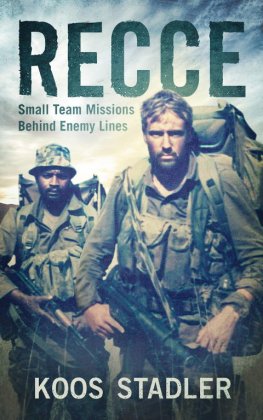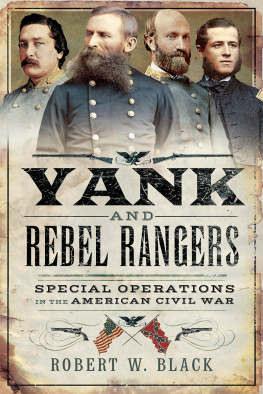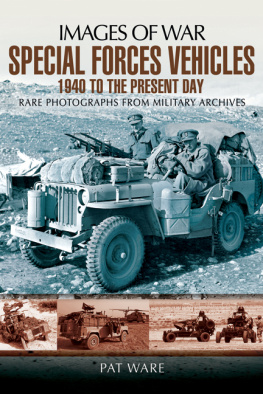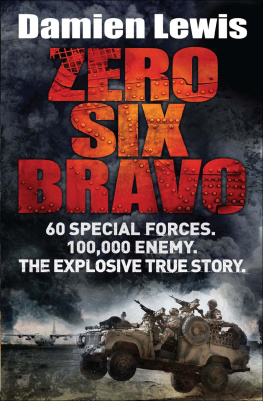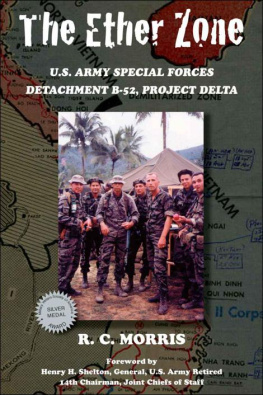Koos Stadler

SMALL TEAM MISSIONS BEHIND ENEMY LINES
Dedicated to my father, Koos,
who kindled the spirit of adventure in me, and my dearest wife, Karien,
who had no option but to scale every cliff with me.
The layout in this digital edition of Recce may differ from that of the printed version, depending on the settings on your reader. The layout displays optimally if you use the default setting on your reader. Readers can experiment with the settings to have the text displayed differently.
I HAVE WRITTEN this book to share something of the world I lived in for more than ten years of my twenty-four-year Special Forces career the little-known world of the Small Team operator. For those ten years I specialised in reconnaissance. I breathed, ate and slept reconnaissance. The experience I gained with the recce wing of 31 Battalion from November 1978 to December 1981 shaped my character and prepared me for life at 5 Reconnaissance Regiment, where I served as a Small Team operator from 1984 to 1989. My subsequent career, both in Special Forces and beyond, was based on the strict code of conduct and principles embedded during that period.
Over the years, the art of reconnaissance became a passion. After being exposed to the intricacies of tactical reconnaissance at 31 Battalions recce wing in the Caprivi, I did Special Forces selection and finally fulfilled my dream of joining Small Teams, the strategic reconnaissance capability of the then Reconnaissance Regiments, commonly known as the Recces. There are many misconceptions and often crazy, fabricated stories out there about Special Forces. Few people perhaps know that there were different Recce units, each with a dedicated field of specialisation. Even fewer people are aware of the existence of the highly specialised Small Teams and the extraordinary role they played in the Border War (19661989).
This book was written over more than two decades. To paint as accurate a picture as possible, I had to rely on notes made over the years, on my memory, on the recollections of my colleagues and on limited documentation. By telling my story I hope to shed some light on the concept as well as the capabilities of the specialist reconnaissance teams of the South African Special Forces. However, I do not attempt to provide a comprehensive history of Small Teams or a detailed account of the stages through which the capability developed.
Since this is a personal account, I can only credit those individuals with whom I deployed. While it isnt possible to mention the names of all the operators who formed part of the specialist reconnaissance fraternity, I wish to acknowledge the pioneers of Small Teams in South Africa, individuals like Koos Moorcroft, Jack Greeff, Tony Vieira and Sam Fourie, and operators like Homen de Gouveia and Justin Vermaak, who did excellent work while with 1 Reconnaissance Regiment. If I omit from my story the names of Special Forces operators who participated in reconnaissance missions during their careers, it is simply because I did not have the privilege of working with them.
More importantly, since there has always been some rivalry between Small Teams and the regular Special Forces commandos, I wish to state that I never doubted their abilities. Neither do I dispute their superior fighting skills nor their excellence in combat. On the contrary, I have been impressed by the level of professionalism of numerous Special Forces soldiers.
Finally, I am happy to share the joys and sorrows I experienced with my comrades, and I proudly recall the unique code of conduct that we lived by, as well as the close bond and mutual respect we shared in both 31 Battalions recce wing and 54 Commando.
KOOS STADLER
ALO air liaison officer
CO candidate officer
CSI Chief of Staff Intelligence
DR dead reckoning
DZ drop zone
E&E escape and evasion
ECCM electronic counter-counter-measures
ECM electronic counter-measures
EMLC electrical, mechanical, agricultural and chemical engineering consultants
FAPLA Foras Armadas Populares de Libertao Angola (Peoples Armed Forces for the Liberation of Angola)
FNLA Frente Nacional de Libertao Angola (National Front for the Liberation of Angola)
HAG helicopter administrative area
HF high frequency
LP listening post
LZ landing zone
MK Umkhonto we Sizwe
MPLA Movimento Popular de Libertao de Angola (Popular Movement for the Liberation of Angola)
NCO non-commissioned officer
OAU Organization of African Unity
OC officer commanding
OP observation post
PLAN Peoples Liberation Army of Namibia
PT physical training
RPG rocket-propelled grenade
RSM regimental sergeant major
RV rendezvous
SADF South African Defence Force
SAM surface-to-air missile
SOPs standard operating procedures
SWAPO South West Africa Peoples Organisation
TB temporary base
UN United Nations
UNITA Unio Nacional para a Independncia Total de Angola (Union for the Total Independence of Angola)
UNTAG United Nations Transition Assistance Group
VHF very high frequency
ZNDF Zambia National Defence Force
PART 1
Courage and Action
~
We fear naught but God
motto of 5 Reconnaissance Regiment, from the units Code of Honour
SILENTLY and with slow, deliberate movements, I slide my pack off. I reach for the first charge and a set of glue tubes. With practised fingers I undo the straps of the pouches and arrange the rest of the charges so I can reach them easily. I feel strangely calm and ready for the task at hand.
The fear I used to experience is absent. Instead, sheer determination has taken over. Deep inside I know that I am well prepared to get the job done and that the stakes are too high for me to fail.
I slip the pack back on and drape my AMD rifle in a firemans sling down the centre of my back to allow freedom of movement. Then I start the stalk towards the MiG-21 fighter jet, silenced pistol cocked and ready in the right hand, charge in the left and night-vision goggles on my chest.
Ten metres from the aircraft, I stop to observe with the night-vision goggles. The darkness of the night is absolute, as we hoped, but it also means that I cannot see below the fuselage of the aircraft. Not even with the beam of the infrared torch can my goggles penetrate the complete blackness under the belly of the huge aircraft crouched on the tarmac.
The night is dead silent. There is no sound from beneath the plane, nor can I make out any shape under the belly. I realise I need to go low to observe better. Slowly and stealthily I ease forward to move into the blackness under the fuselage so I can look up against the ambient light of the sky. I crouch to move in under the wing.
Then suddenly, without warning, a voice pierces the silence of the night from the darkness underneath the plane. My worst fear has just come true.
Who are you?
The voice is hesitant, restrained by fear. Then stronger, more demanding:
Who are you?
The all-too-familiar cocking of a Kalashnikov shatters the fragile night air. Barely three metres away, it cracks invisibly like a rifle shot in the quiet night.
For many years of my adult life I lived in a small world, a world where two people operated in a hostile environment that in a split second could erupt in violence a world of perpetual vigilance. Sometimes we were hundreds of kilometres into enemy territory, miles away from the comforts of suburban life and the reassuring presence of other people. It was a realm far removed from the normal world, one filled with nagging fear and uncertainty, with hunger and thirst.

